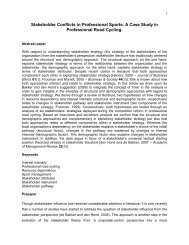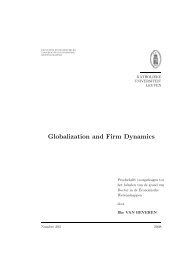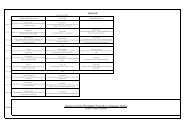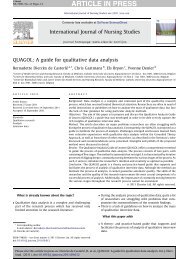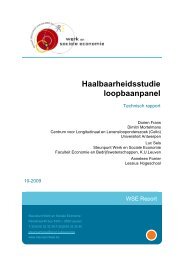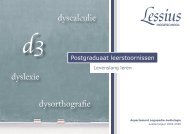The role of implicit attitudes towards food and ... - ResearchGate
The role of implicit attitudes towards food and ... - ResearchGate
The role of implicit attitudes towards food and ... - ResearchGate
Create successful ePaper yourself
Turn your PDF publications into a flip-book with our unique Google optimized e-Paper software.
50 M. Craeynest et al. / Eating Behaviors 9 (2008) 41–51<br />
given the fact that these effects were not found on both performance levels (reaction times <strong>and</strong> percentage <strong>of</strong> errors)<br />
<strong>and</strong> that earlier studies did not show any evidence for <strong>implicit</strong> <strong>attitudes</strong> <strong>towards</strong> physical activity (e.g., Craeynest<br />
et al., 2005; butseeBarton et al., 2004), the <strong>implicit</strong> attitude effects should be interpreted with caution. In contrast,<br />
decrease in overweight seemed to be strongly related to ‘fixed’ variables such as sex, age <strong>and</strong> baseline ABMI (see<br />
also Braet, 2006).<br />
<strong>The</strong>re are several aspects that may <strong>of</strong>fer a possible explanation for the only limited <strong>and</strong> tentative <strong>implicit</strong> attitude effects we<br />
found. First, it is obvious that the small sample size, due to the huge dropout, may have reduced the power <strong>of</strong> the analyses.<br />
Second, the treatment took place in a very controlled setting with strict diet <strong>and</strong> exercise guidelines. Given the<br />
accumulating evidence that the environment is an important predictor for <strong>food</strong> choice <strong>and</strong> physical activity (Booth<br />
et al., 2001), it may be that the decrease in overweight during treatment was rather due to ‘external’ environmental<br />
characteristics, than to ‘internalized’ psychosocial determinants such as <strong>implicit</strong> <strong>attitudes</strong>.<br />
Third, it has been demonstrated that <strong>implicit</strong> measures may not be considered as stable constructs that are<br />
immune for contextual influences (Blair, 2002). <strong>The</strong>refore, it may be that the results were attenuated by the different<br />
contexts in which the youngsters were assessed (at the medical paediatric centre, at the university, <strong>and</strong> for a minority<br />
at home).<br />
Fourth, as mentioned in the Introduction, there is no doubt that using indirect measures may have several advantages<br />
over self-reports (Greenwald et al., 2002). Nevertheless, each <strong>of</strong> the paradigms has its own limitations that should be<br />
considered. With respect to the EAST, at this moment little is known about its validity <strong>and</strong> reliability. Huijding <strong>and</strong> de<br />
Jong (2005) found that a pictorial version <strong>of</strong> the EAST had good predictive validity for avoidance behaviour in<br />
individuals with spider phobia. However, Teige, Schnabel, Banse, <strong>and</strong> Asendorpf (2004) found that the EAST<br />
investigating <strong>implicit</strong> self-concept <strong>of</strong> personality had low internal consistency. Undoubtedly, more research is needed<br />
about the psychometric characteristics <strong>of</strong> the EAST, not only in general, but also within specific domains such as in the<br />
assessment <strong>of</strong> <strong>food</strong> <strong>and</strong> physical activity cognitions in children <strong>and</strong> adolescents. In addition, it should be investigated to<br />
what extent the performance on indirect measures in a longitudinal study design is related to learning effects. Steffens<br />
(2004) found that faking becomes easier after having some experience with an IAT, <strong>and</strong> probably the same is true for<br />
the EAST.<br />
Finally, there are some limitations that should be considered. First, the results <strong>of</strong> the treatment, both on decrease in<br />
overweight <strong>and</strong> on attitudinal change, would have been stronger if they could be compared with those <strong>of</strong> an untreated<br />
group <strong>of</strong> obese youngsters. Second, <strong>food</strong> <strong>and</strong> exercise <strong>attitudes</strong> are not direct determinants <strong>of</strong> weight, but they are<br />
mediated by <strong>food</strong> intake <strong>and</strong> exercise behaviour. <strong>The</strong>refore, future research should include objective behavioural<br />
measures. Moreover, correlations between these behavioural <strong>and</strong> the <strong>implicit</strong> measures can provide then an idea <strong>of</strong> the<br />
validity <strong>of</strong> the <strong>implicit</strong> measures (see Teachman & Woody, 2003).<br />
In sum, this study showed that a decrease in overweight in obese youngsters after a six month inpatient treatment<br />
was not significantly related to self-reported <strong>attitudes</strong>. In contrast, a decrease in overweight seemed to be related to<br />
some changes in <strong>implicit</strong> <strong>attitudes</strong> <strong>towards</strong> <strong>food</strong> <strong>and</strong> physical activity, but these findings should be interpreted with<br />
caution. More research is needed to the psychometric qualities <strong>of</strong> <strong>implicit</strong> measures within this field, <strong>and</strong> to what extent<br />
<strong>implicit</strong> <strong>food</strong> <strong>and</strong> exercise <strong>attitudes</strong> are related to actual <strong>food</strong> intake <strong>and</strong> exercise behaviour.<br />
Acknowledgements<br />
This research was supported by grant B/03814/01 from the Ghent University. We are very grateful to the MPC<br />
Zeepreventorium <strong>and</strong> the children for their cooperation to this study. In addition, we wish to thank Jan De Houwer for<br />
his ideas on conceptualizing the experiment. Furthermore, many thanks go to all colleagues <strong>and</strong> students who assisted<br />
in data collection, especially Els Persijn, Leen Van Vlierberghe, Katrien Verhoeven <strong>and</strong> Mieke De Roo.<br />
Appendix A<br />
Target stimuli <strong>of</strong> the EAST<br />
Target stimuli <strong>food</strong>:<br />
Unhealthy <strong>food</strong> words: crisps, coke, French fries<br />
Healthy <strong>food</strong> words: water, apple, tomato




